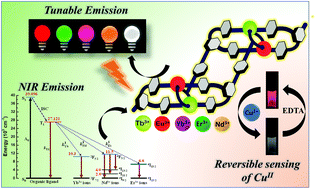Multicolour lanthanide(iii) porous 1D coordination polymers: tunable wide spectrum emission and efficient CuII sensing†
Abstract
Five isostructural 1D porous coordination polymers (PCPs) with a general formula of {[M(L)(DMF)(H2O)]·1.5H2O}n [M = TbIII (1), EuIII (2), YbIII (3), NdIII (4) and ErIII (5)] have been synthesized using a flexible tripodal organic linker (L) and characterized. TbIII (1) and EuIII (2) PCPs exhibit metal-based green and red emission, respectively, whereas YbIII (3), NdIII (4) and ErIII (5) PCPs show near-infrared (NIR) emission. Doping EuIII in 1 in a precisely controlled stoichiometric amount leads to different mixed lanthanide PCPs, {[Tb1−xEux(L)(DMF)(H2O)]·1.5H2O}n (1a–1f) that show tunable emission including that of bright white light. The PCPs decorated with Lewis basic –O– binding sites make them potential candidates for the binding and selective sensing of traces of CuII ions, and this is illustrated for PCP 2 (limit of detection = 0.69 ± 0.02 ppm). The photoluminescence of 2 can be recovered by the introduction of a chelating ligand ethylenediaminetetraacetic acid (EDTA) without any structural disintegration, indicating the potential of the lanthanide PCPs for future sensing applications.

- This article is part of the themed collection: Spotlight Collection: MOF Sensors


 Please wait while we load your content...
Please wait while we load your content...